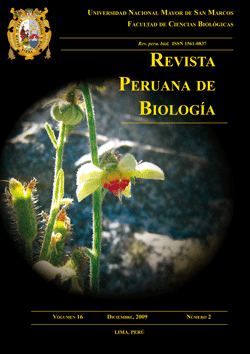In vitro conservation of Dioscorea alata L. clon caraqueño (Dioscoreaceae)
DOI:
https://doi.org/10.15381/rpb.v16i2.207Keywords:
yam, medium-term conservation, cultivation in vitro, mannitol, BAP.Abstract
In this study, we report an efficient method for conservation in vitro of Dioscorea alata L. clone caraqueño during 9 and 12 months based on the culture medium modification (MS to 75% + vitamins MS + sucrose 30 g.L-1 + activated charcoal 2 g.L-1) with different manitol (0; 0,5 and 1,5%) and BAP (0; 0,1 mg.L-1) levels. At 9 and 12 months of in vitro conservation, the following evaluations were determined: survival (%), leaf senility (%), shoot length, buds and microtuber explant count. Plant regeneration (%), shoot length, leaf number and bud explant count were determined at 8 weeks of the nodal cutting regeneration (from vitroplants conserved for 9 and 12 months) in the culture medium (MS to 75% + vitamins MS + sucrose 30 g.L-1 + activated charcoal 2 g.L-1). .Shoot length, leaf number and bud explant count were evaluated at 5 weeks during the conventional micropropagation. The cultivation variants formed by media MS to 75% + vitamins MS + sucrose 30 g.L-1 + activated charcoal 2 g.L-1 and MS to 75% + vitamins MS + sucrose 30 g. l-1 + activated charcoal 2 g.L-1 + BAP 0, 1 mg.L-1 allowed an effective way the conservation of in vitro plants from nodal cutting of clone caraqueño yam during 9 and 12 months with high survival percentages, a significant number of microtubers, smallest leaf senility percentages and 100% regeneration in whole plants with a normal growth in micropropagation conditions.Downloads
Downloads
Published
Issue
Section
License
Copyright (c) 2009 Misterbino Borges García, Yaimara Alarcón Sánchez, Bernard Malaurie, Yanet Hernandez Jerez, Juan Jose Silva Pupo

This work is licensed under a Creative Commons Attribution-NonCommercial-ShareAlike 4.0 International License.
AUTHORS RETAIN THEIR RIGHTS:
a. Authors retain their trade mark rights and patent, and also on any process or procedure described in the article.
b. Authors retain their right to share, copy, distribute, perform and publicly communicate their article (eg, to place their article in an institutional repository or publish it in a book), with an acknowledgment of its initial publication in the Revista Peruana de Biologia.
c. Authors retain theirs right to make a subsequent publication of their work, to use the article or any part thereof (eg a compilation of his papers, lecture notes, thesis, or a book), always indicating its initial publication in the Revista Peruana de Biologia (the originator of the work, journal, volume, number and date).






